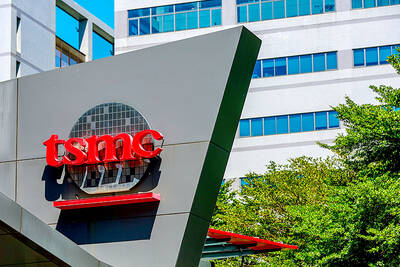China yesterday became the latest country to embrace economic stimulus measures, as its central bank reportedly agreed to lend 100 billion renminbi apiece, or US$16.2 billion, to each of the country’s five main banks.
The decision to inject a total of US$81 billion into the banking system came as the Chinese economy, like many economies in Europe, seemed to slow somewhat over the summer, while still expanding faster than most countries around the world.
Industrial production, retail sales, imports and foreign direct investment have all slackened in China, even as exports are booming.
Stock markets in much of Asia surged yesterday morning in response to the action by the central bank, the People’s Bank of China.
The policy shift was first reported by Chinese Web site Sina.com (新浪網), and two Chinese financiers said it appeared to be true, although neither had yet spoken directly to central bank leaders about the issue. The central bank had no immediate comment.
“I think it’s believable; the economy seems to need stimulus,” one of the financiers said.
Both insisted on anonymity because they were not authorized to discuss government actions.
Asian markets mostly rose yesterday, with Hong Kong and Shanghai boosted by the stimulus injection reports.
However, Tokyo gave up early gains to finish 0.14 percent lower.
China’s five biggest banks, which account for at least three-fifths of the market by various measures, are the Industrial and Commercial Bank of China (中國工商銀行), China Construction Bank (中國建設銀行), Agricultural Bank of China (中國農民銀行), Bank of China (中國銀行) and Bank of Communications (交通銀行).
The five banks will receive the funds in equal amounts over three months through the central bank’s so-called Standing Lending Facility, a tool it uses to manage short-term liquidity, Sina and analysts said.
The report follows a string of weak data for last month, including a five-year low for industrial output growth and a surprise drop in imports, which have put in peril the government’s target of 7.5 percent annual economic expansion for this year.
“Such a move highlights the fact that China’s policymakers are sensitive to the significant weakening seen in the August activity data and the move would be in line with our call that monetary policy will be eased further to boost the economy,” Nomura said in a research note.
The Chinese action comes a day before the European Central Bank begins a program to provide banks with extremely low-rate loans, provided the banks promptly relend the money in the private sector. The European plan also bars banks from lending the money to households for home purchases.
Because the central bank gets to decide in three months whether to extend the loans or call them in, the measure is more limited than, for example, reducing the percentage of a bank’s assets that it must keep as reserves, Western economists said.
Economists at JPMorgan calculated the extra loans would have the same short-term effect as cutting that requirement, called the reserve ratio, by half a percentage point.
Additional reporting by AFP

RUN IT BACK: A succesful first project working with hyperscalers to design chips encouraged MediaTek to start a second project, aiming to hit stride in 2028 MediaTek Inc (聯發科), the world’s biggest smartphone chip supplier, yesterday said it is engaging a second hyperscaler to help design artificial intelligence (AI) accelerators used in data centers following a similar project expected to generate revenue streams soon. The first AI accelerator project is to bring in US$1 billion revenue next year and several billion US dollars more in 2027, MediaTek chief executive officer Rick Tsai (蔡力行) told a virtual investor conference yesterday. The second AI accelerator project is expected to contribute to revenue beginning in 2028, Tsai said. MediaTek yesterday raised its revenue forecast for the global AI accelerator used

Taiwan Semiconductor Manufacturing Co (TSMC, 台積電) has secured three construction permits for its plan to build a state-of-the-art A14 wafer fab in Taichung, and is likely to start construction soon, the Central Taiwan Science Park Bureau said yesterday. Speaking with CNA, Wang Chun-chieh (王俊傑), deputy director general of the science park bureau, said the world’s largest contract chipmaker has received three construction permits — one to build a fab to roll out sophisticated chips, another to build a central utility plant to provide water and electricity for the facility and the other to build three office buildings. With the three permits, TSMC

TEMPORARY TRUCE: China has made concessions to ease rare earth trade controls, among others, while Washington holds fire on a 100% tariff on all Chinese goods China is effectively suspending implementation of additional export controls on rare earth metals and terminating investigations targeting US companies in the semiconductor supply chain, the White House announced. The White House on Saturday issued a fact sheet outlining some details of the trade pact agreed to earlier in the week by US President Donald Trump and Chinese President Xi Jinping (習近平) that aimed to ease tensions between the world’s two largest economies. Under the deal, China is to issue general licenses valid for exports of rare earths, gallium, germanium, antimony and graphite “for the benefit of US end users and their suppliers

Dutch chipmaker Nexperia BV’s China unit yesterday said that it had established sufficient inventories of finished goods and works-in-progress, and that its supply chain remained secure and stable after its parent halted wafer supplies. The Dutch company suspended supplies of wafers to its Chinese assembly plant a week ago, calling it “a direct consequence of the local management’s recent failure to comply with the agreed contractual payment terms,” Reuters reported on Friday last week. Its China unit called Nexperia’s suspension “unilateral” and “extremely irresponsible,” adding that the Dutch parent’s claim about contractual payment was “misleading and highly deceptive,” according to a statement